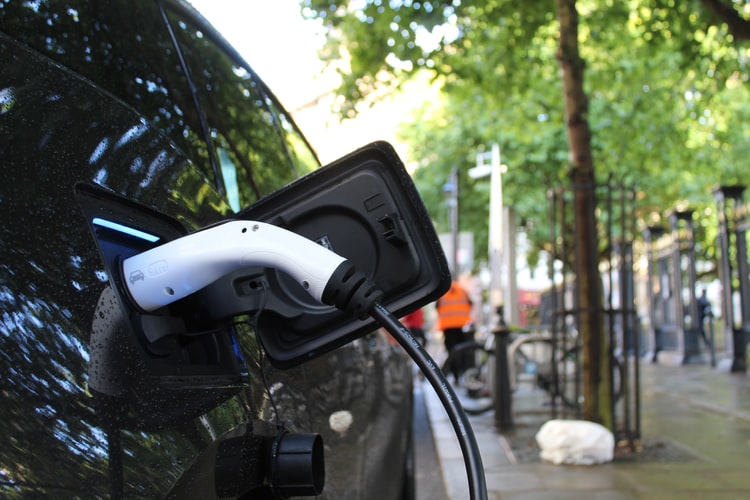Electricity: What is it?
Electricity can be used to power plug-in electric vehicles (PEVs), including both all-electric vehicles, also called battery-electric vehicles, as well as plug-in hybrid electric vehicles. These vehicles can charge their batteries by drawing electricity directly from the grid and other off-board electrical power sources. In contrast, hybrid electric vehicles are fueled with liquid fuels, like gasoline, but use small batteries to recapture energy otherwise lost during braking (ultimately boosting fuel economy). PHEVs can use off-board electricity for power, which classifies them as a PEV, but can also use liquid fuels and operate similar to a HEV if necessary. Using electricity to power vehicles can have significant energy security and emissions benefits.

Benefits & Considerations
Environmental Impact
According to the U.S. Environmental Protection Agency (EPA, 2018), transportation generates the largest share of greenhouse gases at roughly 30%. The largest sources include passenger vehicles and light-duty trucks such as minivans and pickup trucks which account for over half of these emissions. Electric vehicles produce zero tail pipe emissions while driving, meaning they won’t emit harmful gases and can improve air quality as they grow in popularity. While these cars still have a carbon footprint, EVs in Georgia average 65% less emissions than conventional cars. Install a solar panel at you home charging port and you can drop your emissions close to zero.
Performance
Electric motors have a controlled torque of 0 RPM, meaning they have instant acceleration from a standstill stop. EVs also use regenerative braking, which means stepping on the brake can recover up to 10-15% of energy that would have been otherwise wasted in conventional braking system and turns it back into fuel!
Energy Security
The multiple fuel sources used in the generation of electricity results in a more secure and domestically generated energy source for the electrified portion of the transportation sector. This minimize our dependence on foreign oil and adds to our nation’s energy security.
Maintenance
Internal combustion engines have many moving parts that require expensive and continuous upkeep. Can you imagine never having to get an oil change again? The battery, motor, and other parts of the electrical system requires little to no maintenance, and brake systems have an extended life thanks to regenerative braking. The advanced batteries are designed to last the lifetime of the vehicle and can even be recycled after they wear out.
Costs
Typically, driving an electric vehicle costs about half as much as a conventional car. PlugIn America (2020) averages that charging your EV is equivalent to filling up for $1 per gallon of gasoline, or like driving a vehicle that gets over 130 miles per gallon (AFDC, 2019). Although initial purchasing costs of electric cars tend to run higher than their conventional counterparts, these prices can be offset by fuel savings, federal tax credit, and state and utility incentives. Use a cost calculator to compare annual costs associated with your current vehicle versus going electric.
Infrastructure Availability
PHEVs and EVs have the benefit of flexible charging. Since the electric grid is in close proximity to most locations where people park, they can charge overnight at a residence, as well as at a multi-unit dwelling, workplace, or public charging station when available. PHEVs have added flexibility because they can also refuel with gasoline or diesel (or possibly other fuels in the future) when necessary.
Public charging stations, or electric vehicle supply equipment, are not as ubiquitous as gas stations. Charging equipment manufacturers, automakers, utilities, Clean Cities coalitions, municipalities, and government agencies are rapidly establishing a national network of public charging stations. The number of publicly accessible charging stations reached more than 26,000 in 2020, offering more than 80,000 places to charge, according to the Alternative Fueling Station Locator. Search for electric charging stations near you.
Batteries
The advanced batteries in plug-in electric vehicles are designed for extended life but will wear out eventually. Several manufacturers of plug-in vehicles are offering 8-year/100,000-mile battery warranties. Predictive modeling(PDF) by the National Renewable Energy Laboratory indicates that today’s batteries may last 12 to 15 years in moderate climates (8 to 12 years in extreme climates).
Check with your dealer for model-specific information about battery life and warranties. Although manufacturers have not published pricing for replacement batteries, some are offering extended warranty programs with monthly fees. If the batteries need to be replaced outside the warranty, it may be a significant expense. Battery prices are expected to decline as battery technologies improve and production volumes increase. (Courtesy of DOE Alternative Fuel Data Center.)
